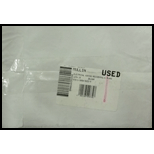
Concept explainers
Name the types of receptacles and switches, and mention the number of receptacles and switches that are used in circuit A14.
Answer to Problem 1R
The types of switches and receptacles used in circuit A14 are listed, and totally four switches and one receptacle are used in circuit A14.
Explanation of Solution
Discussion:
Circuit A14 is a 15-ampere branch circuit that delivers power to the hallway receptacle, the hallway lighting, and the vanity lighting used in bathrooms.
The types of switches and receptacles used in the hallway and bathrooms (Circuit A14) are listed as follows:
- • One receptacle in the hall.
- • One single-pole switch in the hall bathroom.
- • One single-pole switch in the master bathroom.
- • Two 3-way switches in the hall.
Therefore, from the above list, totally four switches and one receptacle are used in the hallway and bathrooms. Hence, a total of five numbers are used in Circuit A14.
Refer to NEC 210.11(C)(3), the receptacles used in the bathrooms are supplied by separate 20-ampere branch circuits A22 and A23.
Conclusion:
Thus, the types of switches and receptacles used in circuit A14 are listed, and totally four switches and one receptacle are used in circuit A14.
Want to see more full solutions like this?
Chapter 10 Solutions
ELECTRICAL WIRING:RESIDENTAL-6 PLANS
- is pf leading, lagging or neither?arrow_forward*please use pen and paper to show work (thank you!!!)* Design a synchronous binary up-counter using 4 negative edge-triggered JK flip-flops provided with a clock. The states (sequences) 1100, 1001 and 1000 are considered as unused states. (i) Draw the state diagram of the counter. (ii) Build the counter’s state table showing the synchronous inputs of the JK flip-flops as well. (iii) Using Karnaugh-maps, find the minimal sum-of-products (SOP) form of the equations for the inputs to the flip-flops; assume the next states of the unused combinations to be <don’t care states=. (iv) Draw the logic circuit of the counter.arrow_forwardSolve this problem and show all of the workarrow_forward
- Design a fuel-cell – Supercapacitor hybrid locomotive with 640 horsepower and a traveling range of 500 km per fully charged hydrogen tank, and consumption rate of 500 Wh/km. The fuel cell provides the driving range and supercapacitor captures the regenerative breaking energy to run the accessories. Assume fuel cell efficiency at 50%. 1hoursepower = 750 W Calculate the size (volume in liter) of a pressurized hydrogen storage tank at 700 bar pressure to deliver the traveling range for the vehicle. Fuel cell voltage at the cell level is 1V. Calculate the volume of solid-state hydrogen storage tank for the vehicle if the solid NaAlH4 is used as a hydrogen storage material. The density of NaAlH4 is 2.8 g/cm3. Atomic weights: Na=23g, Al=27g, and H=1g Calculate the total amount of platinum catalyst loading inside the fuel cell stack, and cost of catalyst if Pt cost as $30/g. Assume catalyst loading on the anodes at 0.02mg/cm2 and 0.04mg/cm2 on the…arrow_forward4. Design an operational amplifier circuit to implement the following mathematical equation. 0.25 dv dtt dvo + ·+ V₁ = Vi dtarrow_forwardsolve and show workarrow_forward
- Problem 4 Consider a unity (negative) feedback system whose open-loop transfer function is given by K(s+1)(s+2) G(s): s(s +10) Assume K = 1. (a) What is the type of the system? (b) Find static position error constant Kp, static velocity error constant Ky and static acceleration error constant Ka (c) Find the steady state-error of the system for following each of the following inputs. (i) (!!) t³ 1(t) (t+2) 1(t) (d) Find the range of K, for which steady-state error of the system for ramp input will be less than 0.05?arrow_forwardAn inner-city metro-bus weighs approximately 10,000 kg including passenger loads, travels 500 km per fully charged battery, and consumes 420 Wh/km. Design a lithium-ion battery pack for the metro-bus using newly developed cells made of silicon anode and lithium manganese-iron phosphate (LMFP) with formulation of Si // 4(LiMn5Fe0.5PO4). The cell average voltage is 3.5V and its capacity 4Ah. The nominal battery pack voltage is 350V. Report the battery pack configuration: Calculate the amount of silicon and LMFP cathode that is required for a single cell at 4Ah capacity. Atomic weight of elements in gram: Si=28 , Li=7, Mn=55, Fe=56, P=31, and O=16. If the building block cell is designed in a cylindrical format (2cm diameter and 10 cm height), calculate the energy density (Wh/lit) and specific energy (Wh/kg) at the cell level and at the battery pack level. Assume cell weight 100g, and cells are arranged in two layers in the battery pack with top…arrow_forwardProblem 2 Consider the following feedback control system. (i) (ii) K(s+2) s(s + 1)(s+3) 5+6 5+7 Use Routh-Hurwitz criterion to find the range of K for which the closed-loop system is stable. Using the Routh table from part (a), find the range of K for which the closed-loop system will have one pole in the ORHP and rest of the poles in the OLHP. This implies there will be only one sign changes in the 1st column.arrow_forward
- Problem 3 Consider the following system where x(t) denotes displacement of the mass from its equilibrium position and u(t) denotes the force applied to the mass. 28 N/m -0000-5 kg. u(t) -x(t) 5 N-s/m (a) Find the transfer function of the system. (b) Is the system internally stable (marginally or strictly) and BIBO stable? (c) Find the settling time, rise time, peak time and percent overshoot for the step-response of the system.arrow_forwardSolve this problem and show all of the workarrow_forwardSolve this problem and show all of the workarrow_forward
 EBK ELECTRICAL WIRING RESIDENTIALElectrical EngineeringISBN:9781337516549Author:SimmonsPublisher:CENGAGE LEARNING - CONSIGNMENT
EBK ELECTRICAL WIRING RESIDENTIALElectrical EngineeringISBN:9781337516549Author:SimmonsPublisher:CENGAGE LEARNING - CONSIGNMENT
